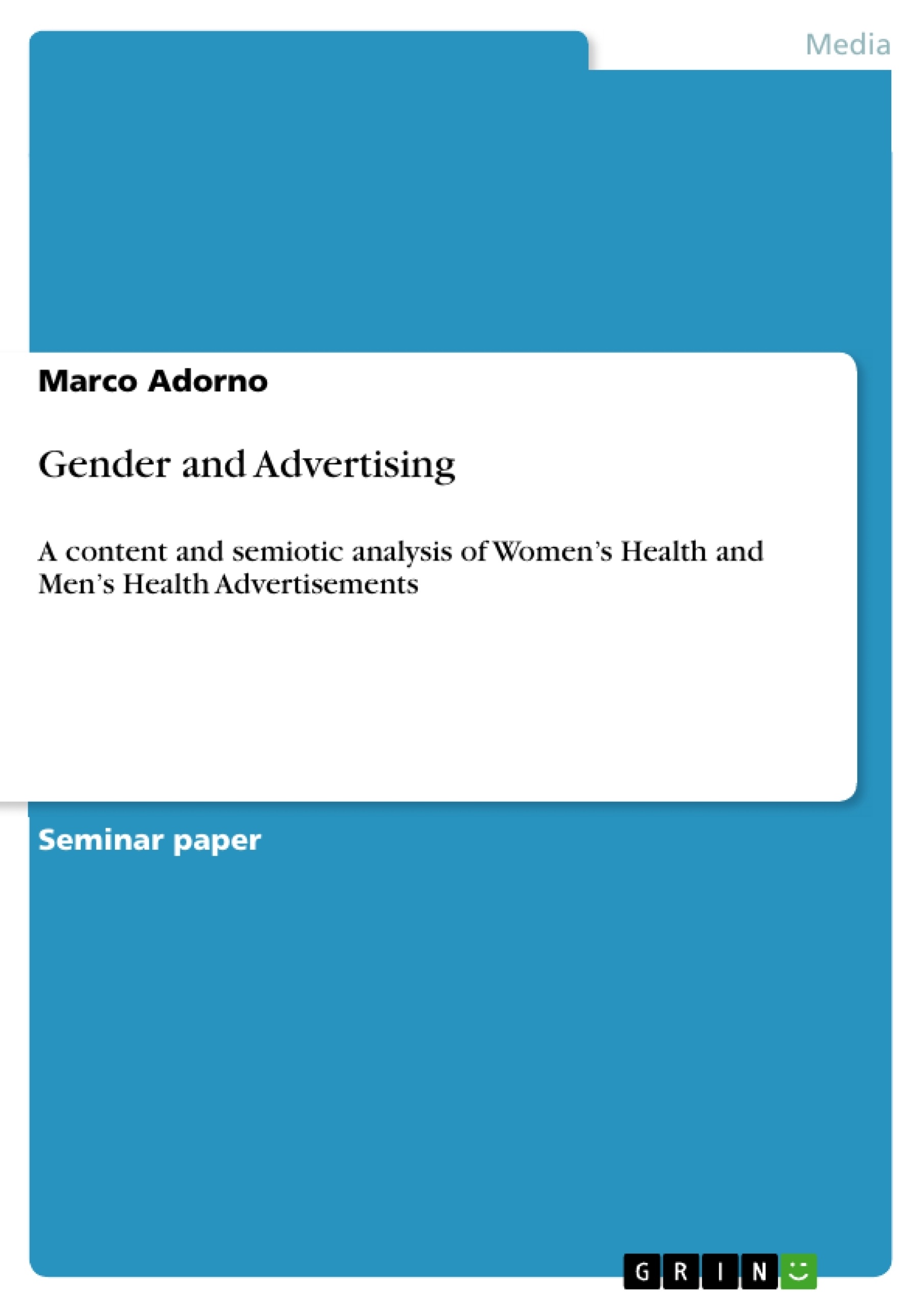In this term paper, in order to analyze how gender roles and stereotypes are built in magazine advertisements, overall 280 advertisements of men's magazine Men’s Health and women's magazine Women’s Health, published in 2012 in the USA, were surveyed. Three issues for each magazine were selected to collect enough data for a content analysis. For the semiotic analysis ten advertisement were chosen as representative of gender advertising that appears in our society.
The final conclusion of this term paper will be that, gender stereotypes are highly expressed, conveyed and confirmed in magazine advertisements and that although changes are visible, they are merely only on the surface, pretending to change.
Table of Contents
- Introduction
- Definitions
- Gender and Advertising
- Theoretical Framework
- Content analysis
- Semiotics
- Methodology
- Results
- Results of content analysis
- Results of semiotic analysis
- Conclusion
Objectives and Key Themes
This term paper analyzes how gender roles and stereotypes are constructed in magazine advertisements. It uses content analysis and semiotic analysis of advertisements from Men's Health and Women's Health magazines to investigate how gender is portrayed. The study aims to understand the influence of advertising on perceptions of gender and to explore how these portrayals reinforce or challenge existing gender norms.
- Gender stereotypes in advertising
- The role of visual imagery in constructing gender
- Content analysis and semiotic analysis of advertisements
- The influence of advertising on gender perceptions
- Comparison of gender representation in men's and women's magazines
Chapter Summaries
Introduction: This introductory chapter sets the stage for the research by highlighting the pervasive influence of advertising in modern life and its impact on shaping societal values and attitudes. It introduces the research objectives—to analyze gender roles and stereotypes in magazine advertisements—and outlines the methodology employed, involving content and semiotic analysis of advertisements from Men's Health and Women's Health magazines. The chapter lays the groundwork for subsequent chapters by discussing the importance of clear definitions regarding sex and gender. It provides a brief overview of previous research on gender portrayals in advertising, citing Goffman (1979) and Cortese (2008) as key influences, and justifies the selection of content analysis and semiotics as the primary analytical methods.
Definitions: This chapter provides essential definitions to clarify the distinction between sex and gender, addressing the common conflation of these terms in everyday language. It highlights the importance of this differentiation for scientific accuracy, explaining sex as biological and gender as a socially constructed concept influenced by cultural factors, socialization, and social expectations. The chapter emphasizes the concept of gender stereotypes as overgeneralizations about individuals based on their assigned gender, illustrating these with examples of masculine and feminine stereotypes presented in a table which shows a binary system of relation. The chapter also mentions the limitation of such a binary system which ignores other gender types.
Gender and Advertising: This chapter delves into the ways in which advertisements utilize visual images of men and women to capture attention and create associations between products and emotional responses. It introduces Goffman's concept of "gender display" and briefly discusses his analysis of gender communication in advertising. The chapter touches upon Cortese's research on the portrayal of women in advertising as sex objects or domestics and sets the context for the subsequent methodological and results sections, which will analyze the chosen advertisements using content analysis and semiotics.
Keywords
Gender, advertising, gender stereotypes, content analysis, semiotics, gender roles, magazine advertisements, visual imagery, Men's Health, Women's Health, gender display, sex, social construction of gender.
Frequently Asked Questions: Comprehensive Language Preview
What is the topic of this term paper?
This term paper analyzes how gender roles and stereotypes are constructed in magazine advertisements, specifically in Men's Health and Women's Health magazines. It investigates how gender is portrayed using content and semiotic analysis.
What are the main objectives of the research?
The study aims to understand the influence of advertising on perceptions of gender and to explore how these portrayals reinforce or challenge existing gender norms. Key themes include gender stereotypes in advertising, the role of visual imagery, and a comparison of gender representation in men's and women's magazines.
What methodologies are used in this research?
The research employs content analysis and semiotic analysis of advertisements from the selected magazines. These methods are used to examine both the explicit and implicit messages conveyed through text and visuals.
What are the key chapters and their summaries?
The term paper includes: an Introduction setting the context and research objectives; a Definitions chapter clarifying sex and gender distinctions; a chapter on Gender and Advertising exploring how advertisements use visuals to construct gender; a Methodology section (implied, but not explicitly summarized); a Results section (implied, but not explicitly summarized) detailing findings from both content and semiotic analysis; and a Conclusion (implied, but not explicitly summarized).
What are the key definitions used in the paper?
The paper clearly defines the difference between sex (biological) and gender (socially constructed). It also addresses gender stereotypes as overgeneralizations about individuals based on their assigned gender.
What theoretical frameworks are utilized?
The research draws upon Goffman's concept of "gender display" and Cortese's work on the portrayal of women in advertising. The theoretical underpinnings include content analysis and semiotics.
What are the keywords associated with this research?
Key words include: Gender, advertising, gender stereotypes, content analysis, semiotics, gender roles, magazine advertisements, visual imagery, Men's Health, Women's Health, gender display, sex, social construction of gender.
What is the overall scope and purpose of this document?
This document serves as a comprehensive preview of the term paper, providing a detailed overview of its contents, including the table of contents, objectives, key themes, chapter summaries, and keywords. It is intended for academic use and analysis.
- Quote paper
- Marco Adorno (Author), 2012, Gender and Advertising, Munich, GRIN Verlag, https://www.grin.com/document/264644




